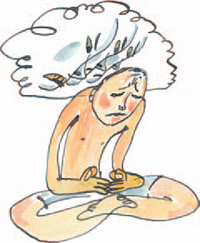Lately I’ve been dealing with a lot of fear during my meditation practice. It seems to come from nowhere, and it either focuses on a specific attachment or it manifests as a more existential, nameless sort of thing. How can I deal with this?

Fear is what happens when reality collides with our personal fiction. Our practice is based on expectations—expectations about who we are, why we are practicing, and what our practice should be. As our hope disintegrates, it may be replaced by fear. Our characteristics, personality, all of our beautiful plans and ideas are like snowflakes about to fall on the hot stone of our meditation practice.
Maybe you’ve poked through boredom and have had a first taste of spaciousness. Until your experience has become stable, the fear remains that your dreams, your life, and your base could fall apart. The more you contemplate space, the more you are aware of the dissolution of everything you have assumed to be real, lasting, and reliable—including your motivation and your practice. Now it all feels transitory and unreliable. This crisis, rooted in dissolution, translates as fear.
This is a seminal moment in our practice. Each time it manifests, each time we are aware of fear, we have a choice: we can acknowledge our problem and work with it, or we can run away from it and seek refuge elsewhere: distractions, pharmaceuticals, weekend feel-good-about-yourself workshops, whatever. We are free to refuse the disappointment and the dissolution. We don’t have to put ourselves back into the situation where the foundation of our being is shaken by the experience of impermanence and emptiness.
But if we decide to continue, if we’re convinced of the sanity of the Four Noble Truths and decide to take refuge in the dharma that the Buddha taught, we need to be courageous. We can choose to take refuge in the brilliant sanity of enlightenment, the Buddha; trust the process of the path, the Dharma; and rely on the experience of those who guide us along the path, the Sangha. We can choose to explore our mind, learn about its problem areas and hidden treasures, but it won’t be comfortable. The guidance of a spiritual friend or teacher is crucial at this stage of our practice.
At the same time, we can be nice to ourselves, accept ourselves as we are and let go of what we are pretending to be. Our crisis is a normal phase. We all enter the spiritual path as ego-based beings, and as such we have ego-based hopes and fears. Practice is virtually never what we expect. We feel like we’ve got it all wrong, thinking, “The more I meditate, the worse I become.” My teacher, Gendun Rinpoche, always responded to this by saying, “When you see your own shortcomings, it’s the dawn of qualities. If you only see your qualities, there’s a problem.”
Related: A Safe Container for Fear
It’s true that if we continue to try to create our personal nirvana through our practice, we’re going to suffer even more. If we use the practice tools that develop intelligence and clarity with a confused, selfish motivation, reality is bound to collide with our fiction. This is where practice is supposed to bring us. This is the proof that the dharma works. It’s the end of our confused, fictive world, and the dawning of truth.
When fear arises within our meditation, we apply an antidote. Recognizing what is happening at each instant as mind, we remain in the present. It is important to remember that patterns don’t have to repeat themselves. Through remaining in the present, we can let go of the past and the future—the headquarters of our fears. We recognize and then we let go, whether coming back to the focal point of our meditation—posture, breath, visualization—or nonconceptual space. Through motivation, honesty, and confidence you can practice with your fears and go beyond in them in a way you never thought possible.